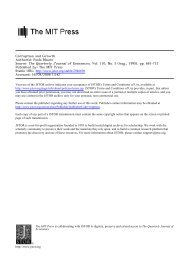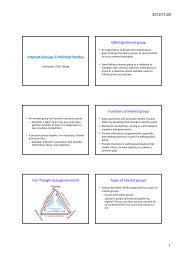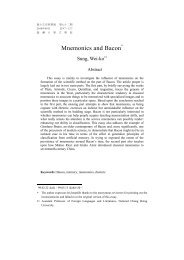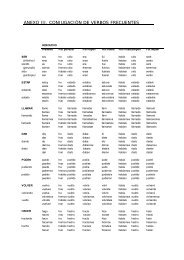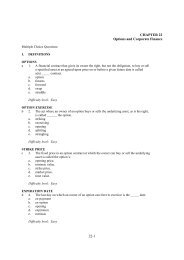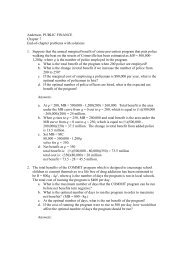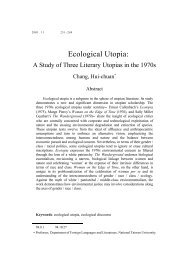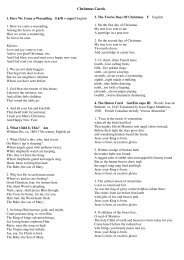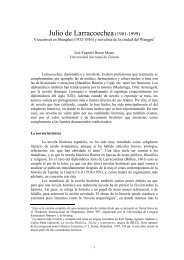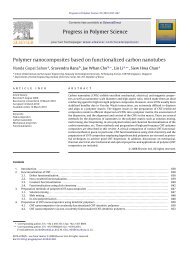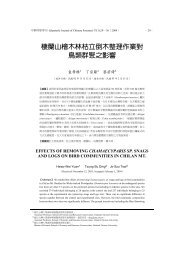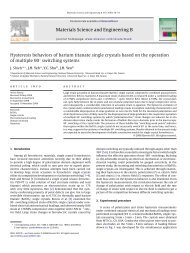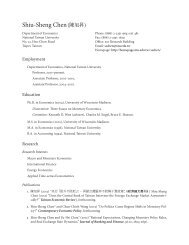Graduate Labor Economics I & II Spring 2012/ Fall 2012 Professor ...
Graduate Labor Economics I & II Spring 2012/ Fall 2012 Professor ...
Graduate Labor Economics I & II Spring 2012/ Fall 2012 Professor ...
Create successful ePaper yourself
Turn your PDF publications into a flip-book with our unique Google optimized e-Paper software.
<strong>Graduate</strong> <strong>Labor</strong> <strong>Economics</strong> I & <strong>II</strong> <strong>Spring</strong> <strong>2012</strong>/ <strong>Fall</strong> <strong>2012</strong><br />
<strong>Professor</strong>: Ming-Jen Lin Social Science Building 224<br />
(O) 23519641*463 email: mjlin@ntu.edu.tw<br />
Grade:<br />
(1) Class Presentation (45%): (a) a 50 mins presentation on an assigned paper(s) or of your<br />
own interest, from our reading list, and (b) a 30 mins presentation on your own final<br />
paper.<br />
(2) Final Paper (45%): an empirical paper with introduction (2 pages), literature review (2-3<br />
pages), data description (1 page), preliminary results (4 pages), and discussion and<br />
conclusion (1-2 pages point out the potential flaws of your paper and suggests ways which<br />
might help to mitigate them). Start to discuss with me after the midterm.<br />
(3) Class Participation (10%): active participation and discussion in the classroom, extra<br />
credit will be given to those who give helpful comments to other students’ presentation.<br />
Course Reading:<br />
Reference Book:<br />
Steven Levitt and Stephen Dubner (2005), Freakonomics, William Morrow(中譯本:蘋果橘<br />
子經濟學,大塊文化)。<br />
Steven Levitt and Stephen Dubner (2010), Superfreakonomics, William Morrow(中譯本:超<br />
爆蘋果橘子經濟學,時報文化)。<br />
Robert Frank (2007), The Economic Naturalist: In Search of Explanations for Everyday<br />
Enigmas (中譯本:經濟自然學,大塊文化)。<br />
0. Introduction<br />
Becker, Gary S. (1976), “The Economic Approach to Human Behavior,” The Economic<br />
Approach to Human Behavior, University of Chicago Press, pp 3-14. (or Becker, Gary<br />
S. (1993), “Nobel Lecture: The Economic Way of Looking at Human Behavior,”<br />
1
Journal of Political Economy, 101(3): 385-409.)<br />
Lucas, Robert E. (1988), “What Economists do?”<br />
Hamermesh, Daniel (2000), “The Craft of <strong>Labor</strong>metrics”, Industrial and <strong>Labor</strong> Relations<br />
Review, 53(3): 363-380.<br />
Freedman, David (1991), “Statistical Models and Shoe Leather”, Sociological Methodology,<br />
21: 291-313.<br />
Angrist, Joshua D. and Alan B. Krueger (1999), “Empirical Strategies in <strong>Labor</strong> <strong>Economics</strong>,”<br />
in Handbook of <strong>Labor</strong> <strong>Economics</strong>, 3A, Chapter 23.<br />
1. <strong>Labor</strong> Supply (Female, tax rate or welfare change)<br />
Imbens, Guido W., Donald Rubin, and Bruce I. Sacerdote (2001), “Estimating the effect of<br />
unearned income on <strong>Labor</strong> Supply, earnings, savings, and consumption: Evidence from a<br />
survey of Lottery winners players,” American Economic Review, 91(4): 778-794.<br />
Bianchi, Marco, Björn R. Gudmundsson, and Gylfi Zoega (2001), “Iceland’s Natural<br />
Experiment in Supply-Side <strong>Economics</strong>,” American Economic Review, 91(5):1564-1579.<br />
Eissa, Nada and Jeffrey B. Liebman (1996), “<strong>Labor</strong> supply response to the earned income tax<br />
credit,” Quarterly Journal of <strong>Economics</strong>, 111(2): 605-637.<br />
Angrist, Joshua D. and William N. Evans (1998), “Children and Their Parents’ <strong>Labor</strong><br />
Supply: Evidence from Exogenous Variation in Family Size,” American Economic<br />
Review, 88(3): 450-77.<br />
Chou, Shin-Yi, Jin-Tan Liu and James K. Hammitt (2003), “National Health Insurance and<br />
Precautionary Saving: Evidence from Taiwan,” Journal of Public <strong>Economics</strong>, 87(9-10):<br />
1873-1894.<br />
Baker, Michael, Jonathan Gruber, and Kevin Milligan (2008), "Universal childcare, maternal<br />
labor supply, and family well-being," Journal of Political Economy, 116(4):709-745.<br />
Blau, Francine D. and Lawrence M. Kahn (2007), “Changes in the <strong>Labor</strong> Supply Behavior of<br />
2
Married Women: 1980–2000,” Journal of <strong>Labor</strong> <strong>Economics</strong>, 25(3): 393-438.<br />
Keane, Michael P. (2011), "<strong>Labor</strong> Supply and Taxes: A Survey," Journal of Economic<br />
Literature, 49(4): 961–1075.<br />
Goldin, Claudia and Lawrence F. Katz (2002), “The Power of the Pill: Oral Contraceptives<br />
and Women’s Career and Marriage Decisions,” Journal of Political Economy, 110(4):<br />
730-770.<br />
2. <strong>Labor</strong> Demand<br />
Card, David and Alan B. Krueger (1994), “Minimum Wages and Employment: A case study<br />
of the Fast food industry in New Jersey and Pennsylvania,” American Economic Review,<br />
84(4): 772-793.<br />
Neumark, David and William Wascher (2000), “Minimum Wages and Employment: A case<br />
study of the Fast food industry in New Jersey and Pennsylvania-Comment,” American<br />
Economic Review, 90(5): 1362-1396.<br />
Card, David and Alan B. Krueger (2000), “Minimum Wages and Employment: A case study<br />
of the Fast food industry in New Jersey and Pennsylvania-Reply,” American Economic<br />
Review, 90(5): 1397-1420.<br />
3. Human Capital<br />
3.1 School, Education, and Wage<br />
Effect of Education on Wage<br />
Mincer, Jacob A. Schooling, Experience, and Earnings. New York: NBER, 1974.<br />
Becker, Gary S., Human Capital. 3rd ed. Chicago: University of Chicago Press, 1993.<br />
Willis, Robert. J. “Wage Determinants,” in Handbook of <strong>Labor</strong> <strong>Economics</strong>, Ch 10, Vol. 1,<br />
Angrist, Joshua D., and Alan B. Krueger(1991), “ Does Compulsory Schooling Attendance<br />
Affect Schooling and Earnings?” Quarterly Journal of <strong>Economics</strong>, 106(4): 979-1014.<br />
Angrist, Joshua D.(1990), “Lifetime Earnings and the Vietnam Era Draft Lottery: Evidence<br />
from Social Security Administrative Records,” American Economic Review, 80(3):<br />
3
313-336.<br />
Ashenfelter, Orley and Alan Krueger (1994), “Estimates of the Economic Return to Schooling<br />
from a New Sample of Twins,” American Economic Review, 84(5): 1157-1173.<br />
Duflo, Esther (2001), “Schooling and <strong>Labor</strong> Market Consequences of School Construction<br />
in Indonesia: Evidence from an Unusual Policy Experiment,” American Economic Review,<br />
91(4): 795-813.<br />
Is Education just a Signal?<br />
Spence, Michael (1973), “Job Market Signaling,” Quarterly Journal of <strong>Economics</strong>, 87(3):<br />
355-374.<br />
Kroch, Eugene A. and Kriss Sjoblom (1994), “Schooling as Human Capital or a Signal: Some<br />
Evidence,” Journal of Human Resources, 29(1): 156-180.<br />
Effect of Class size and Peer on school outcome<br />
Card, David and Alan B. Krueger (1996), “School Resources and Student Outcomes: An<br />
Overview of the Literature and New Evidence from North and South Carolina,” Journal<br />
of Economic Perspectives, 10(4): 31-50.<br />
Hoxby, Caroline M.(2000), “The Effect of Class Size on Student Achievement: New<br />
Evidence from National Population Variation,” Quarterly Journal of <strong>Economics</strong>, 115(4):<br />
1239-1285.<br />
Angrist, Joshua D. and Victory Lavy (1999), “Using Maimonides’ Rule to Estimate the Effect<br />
of Class Size on Scholastic Achievement,” Quarterly Journal of <strong>Economics</strong>, 114(2):<br />
533-575.<br />
Krueger, Alan B. and Diane M. Whitmore (2001), “The Effect of Attending a Small Class in<br />
the Early Grades on College-Test Taking and Middle School Test Results: Evidence<br />
from Project STAR,” Economic Journal, 111(468): 1-28.<br />
Sacerdote, Bruce (2001), “Peer Effect with random assignment: Results for Dartmouth<br />
Roommates,” Quarterly Journal of <strong>Economics</strong>, 116(2): 681-704.<br />
4
Public School Competition<br />
Hoxby, Caroline M.(2000), “Does Competition Among Public Schools Benefit Students and<br />
Taxpayers?” American <strong>Economics</strong> Review, 90(5):1209-1238.<br />
Rothstein, Jesse, “Does Competition Among Public Schools Benefit Students and Taxpayers?<br />
A Comment on Hoxby (2000),” Princeton Working Paper,<br />
http://www.econ.princeton.edu/<br />
3.2 Beauty<br />
Hamermesh, Daniel S. and Jeff E. Biddle (1994), “Beauty and the <strong>Labor</strong> Market,”<br />
American Economic Review, 84(10), 1174-1194.<br />
李承達與駱明慶 (2007),「美貌對候選人得票率的影響--- 以2004年立法委員選舉為<br />
例」,《經濟論文叢刊》,36(1),67-113。<br />
3.3 Health<br />
3.3.1 (Hepatitis B and) Missing Women<br />
Das Gupta, Monica (1987), “Selective discrimination against female children in rural Punjab,<br />
India,” Population and Development Review, 13(1):77-100.<br />
Sen, Amartya (1990), “More Than 100 Million Women Are Missing,” New York Review of<br />
Books, December 20.<br />
Oster, Emily (2005), “Hepatitis B and the Case of the Missing Women,” Journal of Political<br />
Economy, 113(6): 1163-1216.<br />
Das Gupta, Monica (2005), “Explaining Asia’s Missing Women: A New look at the Data,”<br />
Population and Development Review, 31(3): 529-535.<br />
Oster, Emily (2006), “Explaining Asia’s Missing Women: A New Look at the Data –<br />
Comments,” Population and Development Review, 32(2): 323-327.<br />
Das Gupta, Monica (2006), “Cultural Versus Biological Factors in Explaining Asia’s “Missing<br />
Women”: Response to Oster,” Population and Development Review, 32(2): 328-32.<br />
Lin, Ming-Jen and Ming-Ching Luoh (2008), “Can Hepatitis B Mothers Explain the Case of<br />
5
Missing Women? Evidence from Three Millions Newborns in Taiwan,” American<br />
Economic Review, 98(5): 2259-2273.<br />
Lin, Ming-Jen, Jin-Tan Liu, and Nancy Qian (2009), “More Women Missing, Fewer Girls<br />
Dying: The Impact of Abortion on Sex Ratios at Birth and Excess Female Mortality in<br />
Taiwan,” NBER working paper #14541.<br />
3.3.2 AIDS and Human Capital<br />
Oster, Emily (2005), “Sexually Transmitted Infections, Sexual Behavior and the HIV/AIDS<br />
Epidemic,” Quarterly Journal of <strong>Economics</strong>, 120(2): 467-515.<br />
Oster, Emily (2006), “HIV and Sexual Behavior Change: Why Not Africa?” (working paper)<br />
Dupas, Pascaline (2010), “Do Teenagers Respond to HIV Risk Information? Evidence from a<br />
Field Experiment in Kenya”, American Economic Journal: Applied <strong>Economics</strong>, 3(1),<br />
1-34.<br />
Robinson, Jonathan, and Ethan Yeh (2011), "Transactional Sex as a Response to Risk in<br />
Western Kenya", American Economic Journal: Applied <strong>Economics</strong>, 3(1): 35–64<br />
3.3.3 Low Birth Weight<br />
Almond, Douglas, Kenneth Y. Chay and David S. Lee (2005), “The Costs of Low Birth<br />
Weight,” Quarterly Journal of <strong>Economics</strong>, 121(3): 1031-1083.<br />
Behrman, Jere R. and Mark R. Rosenzweig (2004), “Returns to Birth Weight,” Review of<br />
<strong>Economics</strong> and Statistics, 86(2): 586-601.<br />
Lin, Ming-Jen, Liu, Jin-Tan, and Shin-Yi Chou (2007), “As Low Birth Weight Babies Grow,<br />
Can Well-Educated Parents Buffer this Adverse Factor?”, Demography, 44(2): 335-343<br />
Black, Sandra, Paul Devereux and Kjell Salvanes “From the Cradle to the <strong>Labor</strong> Market? The<br />
Effect of Birth Weight on Adult Outcomes.” Quarterly Journal of <strong>Economics</strong>, 122(1):<br />
409-439.<br />
6
Lin, Ming-Jen* and Jin-Tan Liu (2009), "Do Lower Birth Weight Babies Have Lower Grades?<br />
Twin Fixed Effect and Instrumental Variable Method Evidence from Taiwan", Social<br />
Science and Medicine, 68(10), 1780-87.<br />
Wan-Chi Chen, Ming-Jen Lin, and Jin-Tan Liu (2010), “Maternal Age as a Biosocial Link<br />
between Low Birth Weight and Crime Evidence from Taiwan's National Data,” Social<br />
Science Research, 33(6), 1047-1058.<br />
3.3.4 Fetus Origin (or the Economic Consequence of 1918 Influenza, Malaria, Radioactive<br />
fallout, Worms, etc)<br />
Almond, Douglas, and Janet Currie. 2011. “Killing Me Softly: the Fetal Origin Hypothesis,”<br />
Journal of Economic Perspective, 25(3):153-172.<br />
Almond, Douglas (2006), “Is the 1918 Influenza Pandemic Over? Long-term Effects of In<br />
Utero Influenza Exposure in the Post-1940 U.S. Population,” Journal of Political<br />
Economy, 114(4): 672-712.<br />
Lin, Ming-Jen (<strong>2012</strong>), "Does “in Utero” Exposure to Illness Matter? The 1918 Influenza<br />
Epidemic in Taiwan as a Natural Experiment," Working Paper.<br />
劉奕文(2008),「胎兒時期的病毒接觸與未來發展是否相關?以 1918 年全球大流感對台<br />
灣教育程度的影響為例」,台大經研所碩士論文。<br />
Almond, Douglas and Bhashkar Mazumder (2011), “Health Capital and the Prenatal<br />
Environment: The Effect of Ramadan Observance during Pregnancy”, American<br />
Economic Journal: Applied <strong>Economics</strong>, 3(4): 56-85.<br />
Almond, Douglas, Lena Edlund, and Mårten Palme. 2009. “Chernobyl's Subclinical Legacy:<br />
Prenatal Exposure to Radioactive <strong>Fall</strong>out and School Outcomes in Sweden.” The<br />
Quarterly Journal of <strong>Economics</strong>, 124(4):1729-1772.<br />
Banerjee A. V., E. Duflo, G. P. Vinay, and T. Watts. 2008. “Long Run Health Impacts of<br />
Income Shocks: Wine and Phylloxera in 19th Century France.” forthcoming, Review of<br />
<strong>Economics</strong> and Statistics.<br />
7
Bleakley Hoyt. 2007. “Disease and Development: Evidence form Hookworm Eradication in<br />
the American South.” The Quarterly Journal of <strong>Economics</strong>,122(1): 73-117.<br />
Bleakley Hoyt. 2009. “Economic Effects of Childhood Exposure to Tropical Disease,”<br />
American Economic Review Paper and Proceeding, 99(2), pp 218-223.<br />
Bleakley, Hoyt (2010), “Malaria Eradication in the Americas: A Retrospective Analysis of<br />
Childhood Exposure”, American Economic Journal-Applied, 2(2), pp 1-45.<br />
Lucas, Adrienne (2010), “Malaria Eradication and Educational Attainment: Evidence from<br />
Paraguay and Sri Lanka” American Economic Journal-Applied <strong>Economics</strong>,2(2), pp<br />
46-71.<br />
Cutler, David, Winnie Fung, Michael Kremer, Monica Singhal and Tom Vogl (2010), “Early-Life<br />
Malaria Exposure and Adult Outcomes: Evidence from Malaria Eradication in India”, American<br />
Economic Journal-Applied, 2(2), pp 72-94.<br />
3.3.5 Height and Weight<br />
Persico, Nicola, Andrew Postlewaite and Dan Silverman (2004), “The Effect of Adolescent<br />
Experience on <strong>Labor</strong> Market Outcomes: The Case of Height,” Journal of Political<br />
Economy, 112(5): 1019-1053.<br />
Case, Ann and Christina Paxson (2008), “Stature and Status: Height, Ability, and <strong>Labor</strong><br />
Market Outcomes,” Journal of Political Economy, 116(3), pp 499-532<br />
Deaton, Angus and Raksha Arora (2009), "Life at the Top: The Benefits of Height," <strong>Economics</strong><br />
and Human Biology, 7(2), pp 133-136.<br />
Heineck, Guido (2009), “Too Tall to be Smart? The Relationship between Height and Cognitive<br />
Abilities,” <strong>Economics</strong> letters, 105(1), pp 78-80.<br />
Hüble, Olaf (2009), “The nonlinear link between height and wages in Germany, 1985–2004,”<br />
<strong>Economics</strong> and human biology, 7(2) pp 191-199.<br />
蔡欣純(2009),“「身高對學生綜合能力分析的影響以男女生第一次夢遺/初經年齡為工<br />
具變數分析」",台大經研所碩士論文。<br />
8
Cutler, DM, EL Glaeser, and JM Shapiro (2003), “Why Have Americans Become More<br />
Obese?”, Journal of Economic Perspectives 17, pp 93-118.<br />
Lakdawalla, D and Thomas Philipson (2009), “The Growth of Obesity and Technological<br />
Change”, <strong>Economics</strong> and Human Biology, 7, pp 283-293.<br />
Chou, Shin-Yi, I Rashad and Michael Grossman (2008), “Fast-Food Restaurant Advertising<br />
on Television and Its Influence on Childhood Obesity”, Journal of Law and <strong>Economics</strong>,<br />
51, pp 599-618.<br />
Komlos, John and Marek Brabec (2010), “The Trend of BMI Values by Deciles of US Adults,<br />
birth cohorts 1882-1986,” NBER Working Paper 16252 (also see the 08/31/2010 VOX<br />
column).<br />
Philipson, Thomas and Richard Posner(2010), Fat New World, Opinion, July 30, 2010 Wall<br />
Street Journal<br />
Cawley, John. (2004), “The Impact of Obesity on Wages,” Journal of Human Resources,<br />
39(2): 451-474.<br />
3.3.6 What’s in a good terrorist?<br />
Benmelech, Efrain and Claude Berreb (2007), “Human Capital and the Productivity of<br />
Suicide Bombers,” Journal of Economic Perspectives, 21(3): 223-238.<br />
Krueger, Alan (2007), What Makes a Terrorist: <strong>Economics</strong> and the Roots of Terrorism,<br />
Princeton University Press<br />
3.3.7 Famine<br />
Meng, Xin and Nancy Qian: “The Long Run Health and Economic Consequences of Famine<br />
on Survivors: Evidence from China’s Great Famine,” IZA discussion paper 2471.<br />
Chen, Yuyu & Zhou, Li-An, "The long-term health and economic consequences of the<br />
1959-1961 famine in China," Journal of Health <strong>Economics</strong>, 26(4): 659-681,<br />
3.4 Human Capital (Education and Ethnicity)<br />
9
駱明慶(2002), 「誰是台大學生?--- 性別、省籍和城鄉差異,」《經濟論文叢刊》,<br />
30(1): 113-147。<br />
駱明慶(2001),「教育成就的省籍與性別差異,」《經濟論文叢刊》 ,29(2): 117-152。<br />
陳婉琪(2005),「族群、性別與階級:再探教育成就的省籍差異,」《台灣社會學》,<br />
10: 1-40。<br />
駱明慶 (2003), 「高普考分省區定額錄取與特種考試的省籍篩選效果」 《經濟論文叢<br />
刊》, 31(1), 87-106。<br />
林郁芳 (2009), 「再探政黨偏好的社會分歧—代間教育流動的影響」,台大經研所碩<br />
士論文。<br />
3.5 Language as a Form of Human Capital<br />
Chiswick, Barry and Paul Miller (1995), “The Endogeneity between Language and Earnings:<br />
International Analyses,” Journal of <strong>Labor</strong> <strong>Economics</strong>, 13(2), pp 246-88.<br />
Chiswick, Barry and Paul Miller (2001), “A Model of Destination-Language Acquisition:<br />
Application to Male Immigrants in Canada,” Demography, 38(3), pp 391-409.<br />
Bleakley, Hoyt and Aimee Chin (2010), “Age at Arrival, English Proficiency, and Social<br />
Assimilation among U.S. Immigrants,” American Economic Journal: Applied, 2(1):<br />
165-192.<br />
Bleakley, Hoyt and Aimee Chin (2008), “What Holds Back the Second Generation? The<br />
Intergenerational Transmission of Language Human Capital Among Immigrants,”<br />
Journal of Human Resources, 43(2), pp 267-298.<br />
Bleakley, Hoyt and Aimee Chin (2004), “Language Skills and Earnings: Evidence from<br />
Childhood Immigrants,” Review of <strong>Economics</strong> and Statistics, 86(2):481-496.<br />
陳婉琪、溫郁文 (2010) 講啥米話咁唔要緊?語言資本對族群間職業取得差異的影響。<br />
台灣社會學刊 44, pp 1-54。<br />
3.6 Discrimination and Cheating<br />
10
Becker, Gary (1957), The <strong>Economics</strong> of Discrimination, University of Chicago Press.<br />
Bertrand Marianne and Sendhil Mullainathan (2004), “Are Emily and Greg More Employable<br />
than Lakisha and Jamal? A Field Experiment on <strong>Labor</strong> Market Discrimination,” American<br />
Economic Review, 94(4): 991-1013.<br />
Gneezy, Uri, and John A. List (2006), “Clean Evidence of Statistical Discrimination Against<br />
the Physically Disabled in Product Markets: Evidence from a Field Experiment.”<br />
(working paper)<br />
Duggan, Mark and Steven D. Levitt (2002), “Winning Isn't Everything: Corruption in Sumo<br />
Wrestling,” American Economic Review, 292(5): 1594-1605.<br />
Jacob, Brian A. and Steven D. Levitt (2003), “Rotten Apples: An Investigation of the<br />
Prevalence and Predictors of Teacher Cheating,” Quarterly Journal of <strong>Economics</strong>,<br />
118(3): 843-877.<br />
3.7 Sex, Pornography and Prostitution<br />
Gertler, Paul, Manisha Shah, and Stefano M. Bertozzi (2005), “Risky Business: The Market<br />
for Unprotected Commercial Sex,” Journal of Political Economy, 113(3): 518-550.<br />
Francis, Andrew (2007), “The <strong>Economics</strong> of Sexuality: The Effect of HIV/AIDS on<br />
Homosexual Behavior, Desire, and Identity in the United States,” Ph.D. Thesis, the<br />
university of Chicago.<br />
吳明燁 (2007) ,「色情出版物、青少年性行為與升學意願」, 台灣大學經濟研究所<br />
碩士論文。<br />
Edlund, Lena, Joseph Engelberg and Christopher A. Parsons(2009), "The Wages of Sin,"<br />
Columbia University Discussion Paper No.: 0809-16, June 4, 2009.<br />
Edlund, Lena and Evelyn Korn (2002), "A Theory of Prostitution," The Journal of Political<br />
Economy, 110(1): 181-214.<br />
Levitt, Steve and Sudhir Venkatesh(2007), “An Empirical Analysis of Street Level<br />
Prostitution,” Working Paper.<br />
11
3.8 Economic History of Slavery, Potatoes, and Plow Use<br />
Nunn, Nathan and Nancy Qian (2010), “The Columbian Exchange: A History of Disease,<br />
Food, and Ideas," Journal of Economic Perspectives, 24(2):163-188.<br />
Nunn, Nathan (2008), “The Long Term Effects of Africa's Slave Trades," Quarterly Journal<br />
of <strong>Economics</strong>,123(1): 139-176.<br />
Alesina, Alberto, Paola Giuliano, and Nathan Nunn (2011) “Fertility and the Plough”,<br />
American Economic Review Papers and Proceedings,101(3): 499-503.<br />
Nunn, Nathan and Nancy Qian (2011), The Potato's Contribution to Population and<br />
Urbanization: Evidence from a Historical Experiment," Quarterly Journal of <strong>Economics</strong>,<br />
126(2): 593-650.<br />
3.9 Women Status<br />
Hu, L. and Schlosser, A. (2011), "Prenatal Sex Selection and Girls’ WellBeing: Evidence<br />
from India." Federal Reserve Bank of Chicago.<br />
傅君琦(<strong>2012</strong>):市場的力量:從性比例失衡看印度婦女地位的變化,台灣大學經濟研究所<br />
碩士論文。<br />
Jenson, Robert and Emily Oster (2009), “The Power of TV: Cable Television and Women’s<br />
Status n India,”Quarterly Journal of <strong>Economics</strong> 124(3): 1057-1094.<br />
區俊傑(2011):電視對印度女性地位的影響,台灣大學經濟研究所碩士論文。<br />
4. Personnel <strong>Economics</strong> (Internal <strong>Labor</strong> Markets)<br />
4.1 Overview<br />
Karpoff, Jonathan M. (2001), “Public versus Private Initiative in Arctic Exploration: The<br />
Effects of Incentives and Organizational Structure,” Journal of Political Economy, 109(1):<br />
38-78.<br />
Gibbons, Robert S.(1997), “Incentives and Careers in Organizations.” In Advances in<br />
<strong>Economics</strong> and Econometrics: Theory and Applications, 7th World Congress, Vol. 2,<br />
12
edited by D. Kreps and K. Wallis. New York: Cambridge University Press<br />
Baker, George, Michael Gibbs and Bengt Holmstrom (1994a), “The Internal <strong>Economics</strong> of<br />
The Firm: Evidence From Personal Data,” Quarterly Journal of <strong>Economics</strong>, 109(4):<br />
881-919.<br />
Baker, George, Michael Gibbs and Bengt Holmstrom (1994b), “The Wage Policy of a Firm:<br />
Evidence From Personal Data,” Quarterly Journal of <strong>Economics</strong>, 109(4): 921-955.<br />
Lin, Ming-Jen (2005), “Opening up the Black Box - The Internal <strong>Labor</strong> Market of Company<br />
X,” Industrial Relations., 44(4): 659-706.<br />
4.2 Tournament<br />
Lazear, Edward and Sherwin Rosen (1981), “Rank-Order Tournaments as Optimum <strong>Labor</strong><br />
Contracts,” Journal of Political Economy, 89(5): 841-864.<br />
Eriksson, Tor. (1999). “Executive Compensation and Tournament Theory: Empirical Tests on<br />
Danish Data.” Journal of <strong>Labor</strong> <strong>Economics</strong>, 17(2): 262–280.<br />
Lin, Ming-Jen (2008), “External Market Condition and Tournaments: Theory and Evidence”,<br />
forthcoming, <strong>Economics</strong> Letters.<br />
4.3 Piece rate<br />
Lazear, Edward (1986), “Salaries and Piece Rates.” Journal of Business, 59(3):1346–1361.<br />
Edward, Lazear (2000), “Performance Pay and Productivity.” American Economic Review<br />
90(5):1346–1361.<br />
Bandiera Oriana, Iwan Barankay, Imran Rasul (2005), “Social Preferences and the Response<br />
to Incentives: Evidence from Personnel Data”, Quarterly Journal of <strong>Economics</strong>, 120(3):<br />
917-962.<br />
5. <strong>Economics</strong> of Crime<br />
Abortion<br />
Levitt, Steven D. and John J. Donohue <strong>II</strong>I (2001), “The Impact of Legalized Abortion on<br />
13
Crime,” Quarterly Journal of <strong>Economics</strong>, 116(2): 379-420.<br />
Pop-Eleches, Cristian (2006), “The Impact of an Abortion Ban on Socioeconomic Outcomes<br />
Police:<br />
of Children: Evidence from Romania,” Journal of Political Economy, 114(4): 744-773.<br />
Levitt, Steve D.(1997), “Using Electoral Cycle in Police Hiring to Estimate the Effect of<br />
Police on Crime,” American Economic Review, 87(3): 270-290.<br />
McCray, Justin. E. (2002), “Using Electoral Cycle in Police Hiring to Estimate the Effect of<br />
Police on Crime: Comment,” American Economic Review, 92(4): 1236-1243.<br />
Levitt, Steve D. (2002), “Using Electoral Cycle in Police Hiring to Estimate the Effect of<br />
Police on Crime: Reply, American Economic Review, 92(4): 1244-1250.<br />
Lin, Ming-Jen (2006), “More Police, Less Crime,” minor revision, International Review of<br />
Law and <strong>Economics</strong>.<br />
Unemployment:<br />
Lin, Ming-Jen (2008), “Does Unemployment Increase Crime? Evidence from US State Data<br />
1971-2000,” forthcoming, Journal of Human Resource.<br />
林明仁與劉仲偉 (2006),「失業真的會導致犯罪嗎?以台灣地區 1978 年至 2003 年縣市<br />
Gang<br />
資料為例,」《經濟論文叢刊》, 34(4): 445-483。<br />
Levitt, Steven D. and Sudhir Alladi Venkatesh (2000), “An Economic Analysis of a Drug<br />
Gun<br />
Selling Gang's Finances,” Quarterly Journal of <strong>Economics</strong>, 115(3): 755-789.<br />
John R. Lott, Jr. and David B. Mustard (1997), “Crime, Deterrence and Right-to-Carry<br />
Concealed Handguns,” Journal of Legal Studies, 26(1): 1-68.<br />
Ludwig, Jens Otto (1998), “Concealed-Gun-Carrying Laws and Violent Crime: Evidence<br />
from State Panel Data,” International Review of Law and <strong>Economics</strong>, 18(3): 239-254.<br />
Duggan Mark (2001), “More Guns, More Crime,” Journal of Political Economy, 109(5):<br />
14
1086-1114.<br />
Levitt, Steven and Steve Dunber, Freakonomics, pp 130-134.<br />
Democracy<br />
Lin, Ming-Jen (2007), “Does Democracy Increase Crime? Evidence from International Data,”<br />
Journal of Comparative <strong>Economics</strong>, 35(3): 467-483.<br />
6. Experimental <strong>Economics</strong><br />
Steven D. Levitt and John A. List (2009), “Field Experiments in <strong>Economics</strong>: The Past, The<br />
Present, and The Future”, European Economic Review, 53(1), pp 1-18.<br />
List, John and Imran Rasul(2010), “Field Experiment in <strong>Labor</strong> <strong>Economics</strong>”, NBER working<br />
Paper 16062.<br />
List, Harrison, W. Glenn and John A. List (2004),“Field Experiments,”Journal of<br />
Economic Literature, 42(4) : 1009-1055.<br />
List, J.A., S. Sadoff, M. Wagner (2008), “So you want to run an experiment, now what? Some<br />
Simple Rules of Thumb for Optimal Experimental Design”, NBER Working Paper<br />
15701.<br />
List, John A. (2004), “The Nature and Extent of Discrimination in the Marketplace: Evidence<br />
from the Field,” Quarterly Journal of <strong>Economics</strong>, 119(1): 49-89.<br />
Gneezy, Uri, and John A. List (2006), “Putting Behavioral <strong>Economics</strong> to Work: Testing for<br />
Gift Exchange in <strong>Labor</strong> Markets Using Field Experiments,” Econometrica, 74(5):<br />
1365-1384.<br />
List, John A. (2006), “The Behavioralist Meets the Market: Measuring Social Preferences and<br />
Reputation Effects in Actual Transactions,” Journal of Political Economy, 114(1): 1-37.<br />
List, John A (2003) “Does Market Experience Eliminate Market Anomalies?” Quarterly<br />
Journal of <strong>Economics</strong>, 118(1): 41-71.<br />
Gneezy, Uri, and John A. List, (2006), “Clean Evidence of Statistical Discrimination Against<br />
the Physically Disabled in Product Markets: Evidence from a Field Experiment.”<br />
15
(working paper)<br />
Gneezy, Uri, John A. List, and Michael Price, (2006), “Sexual Orientation and Discrimination<br />
in the Market for New Cars.” (working paper)<br />
7. Gender Difference<br />
7.1 Can Women be Good Scientists?<br />
Some Background can be found at the following four posts at Becker-Posner Blog:<br />
(1) Larry Summers and Women Scientists: Jan 30, 2005.<br />
(2) The Summers Controversy and University Governance: Feb 27, 2005.<br />
(3) Summers’ Resignation and University Governance: Feb 26, 2006.<br />
(4) Summers' Resignation and Organization Theory: Feb 26, 2006.<br />
Xie, Yu and Kimberlee A. Shauman (2005), Women in Science: Career Processes and<br />
Outcomes, Harvard University Press.<br />
7.2 Are Men over-confident?<br />
Niederle, Muriel, and Lise Vesterlund (2007), “Do Women Shy away from Competition?<br />
Do Men Compete too Much?,” Quarterly Journal of <strong>Economics</strong>, 122(3): 1067-1101.<br />
7.3 Do boys have lower grade than girls?<br />
We will look at Taiwan’s Data on this topic.<br />
8. How to write a term paper and thesis<br />
Wayne C. Booth, Gregory G. Colomb, and Joseph M. Williams (2008), Crafts of Research, 3 rd<br />
ed, University of Chicago Press.<br />
Howard Becker (1998): Tricks of Trade, University of Chicago Press.<br />
Howard Becker (2007): Writing for Social Scientist, 2 nd ed, University of Chicago Press.<br />
16



